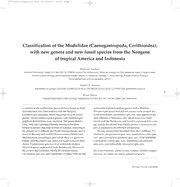
Classification of the Modulidae (Caenogastropoda, Cerithioidea), with new genera and new fossil species from the Neogene of tropical America and Indonesia PDF
Preview Classification of the Modulidae (Caenogastropoda, Cerithioidea), with new genera and new fossil species from the Neogene of tropical America and Indonesia
B77-2013-11:Basteria-2010 07/08/2014 21:23 Page 1 Classification of the Modulidae (Caenogastropoda, Cerithioidea), with new genera and new fossil species from the Neogene of tropical America and Indonesia Bernard Landau NaturalisBiodiversityCenter,P.O.Box9517,NL-2300RALeiden,TheNetherlands;CentrodeGeologiadaUniversidadedeLisboa.CampoGrande, 1749-016Lisboa,PortugalandInternationalHealthCentres,Av.InfantedeHenrique7,AreiasSãoJoão,P-8200Albufeira,Portugal; [email protected][Correspondingauthor] Geerat J. Vermeij DepartmentofGeology,UniversityofCaliforniaatDavis,OneShieldsAvenue,Davis,CA95616USA;[email protected] 1 Sonja Reich NaturalisBiodiversityCenter(GeologyDepartment),P.O.Box9517,NL-2300RLLeiden,TheNetherlands. ArevisionofthecerithioideangenusModulus,basedonshell exclusivelytropicalAmericangenera,withaMiocene- charactersandnewfossilmaterialfromtheNeogene Pliocenefossilrecordthatdidnotsurvivetothepresentday. CaribbeanandIndonesia,showsthegroupnottobemono- IntheIndo-Pacific,Indomodulusgen.nov.firstappearsinthe generic.Severaldistinctspeciesgroups,withrestrictedgeo- earlyMioceneofIndonesia,afterwhichthereisnofossil graphicaldistributions,wereidentified.ThegenusModulus recorduntilthePleistocene,andistodayrepresentedbyasin- Gray,1842,hasageologicalhistorystartinginthelatest gle,widely-distributedIndo-Pacificspecies.Conomodulusnov. EocenetoearliestOligoceneintropicalAmerica,extendingto gen.isrestrictedtotheMioceneofIndonesia. thepresentdayCaribbeanandPacificPanamicfaunas,andis Sixnewspeciesweredescribed;fromtheCaribbean:Tro- foundintheearlyandmiddleMioceneeasternAtlanticand chomodulusparaguanenesisspec.nov.,Laevimoduluscanaespec. Mediterraneanassemblages,afterwhichthereisagapinits nov.,andLaevimodulusgurabensisspec.nov.;fromIndonesia: historyuntilthepresentday,whenitisfoundlivingoffWest Conomodulusrenemaispec.nov.,Indomoduluspseudotectum Africa.Trochomodulusgen.nov.isanexclusivelytropical spec.nov.,andIndomodulusmiocenicumspec.nov. Americangenus,representedfromthelate-earlyMioceneto thepresentdayCaribbeanandPacificPanamicfaunas. Keywords:Modulidae,genericrevision,NeogeneCaribbean,Neogene Laevimodulusgen.nov.andPsammodulusCollins,1934,arealso Indonesia,newgenera,newspecies,palaeobiogeography. Basteria78(1-3):1-29(2014) B77-2013-11:Basteria-2010 07/08/2014 21:23 Page 2 Introduction Americanfossilspecies,placingspecialattentiontothecol- 1 umellararea.WhilstintheRecentfaunasmodulidsarelo- TherichanddiverseNeogeneassemblagesfromthenorth- callyfoundinlargenumbers,inthefossiltropicalAmerican ernDominicanRepubliccollectedaspartofthePanamaPa- andIndonesianassemblagestheyareuncommon.Modulids leontologyProjectandnowhousedintheNaturhistorisches inhabitrockyandseagrassenvironments.Rockyenviron- MuseumBasel(Switzerland)andtheBernardLandaucol- mentsareknowntobepoorlyrepresentedinthetropical lectionshousedintheNaturhistorischesMuseumWien AmericanNeogenerecord(Vermeij,2001a),whereassea- (Austria)continuetoprovidespeciesasyetunknowntosci- grasscommunitiesarenot.Whymodulidsshouldbesoun- ence.Althoughallthesespeciesrequireformaldescription, commoninfossilassemblagesisunclear.Nevertheless,this somearemoreremarkablethanothers.Inthispaperwetake resultsinasmallnumberofspecimensfromalargenumber theopportunitytodescribesomemodulidsquiteunlikeany ofwidelygeographicallyandstratigraphicallyseparatedde- ofthoseknowninthefossilorRecentfaunas. posits.Thesmallnumberofspecimensfromeachassem- Modulidsoccurworldwideintropicalwaters,butare blagemakesintraspecificvariabilitydifficulttoevaluate. notspeciose,withonlyaboutadozenRecentspecies Whenevertheshellcharactersbetweenthefossilpopula- known,althoughsomeofthesemaybesynonyms.Consid- tionsdifferedconsistently,theywereconsidereddistinct eringthispaucityofspecies,thefamilyiswellrepresented species.Thismightbeconsideredbysometobearather inthetropicalAmericanfossilandRecentfaunas,but narrowtaxonomicviewpoint,especiallywiththespecies seemedtobeverypoorlyrepresentedintheIndo-Pacificfos- heredescribedunderthegenusTrochomodulusgen.nov.(i.e. silrecord.Inthecourseofthepreparationofthiswork,fur- T.paraguanensisspec.nov.,T.vermeiji,T.tamanensis).How- therrecordsforfossilmodulidsweresoughtforthe ever,inourexperience,atspecieslevel,tropicalAmerican Indo-Pacific,andfoundwithinthecollectionsoftheNatu- Neogenefaunastendhavearapidturnoverandbehighly 2 ralisBiodiversityCentre,whichhousesasuperbcollection endemic,and“splitting”ratherthan“lumping”turnoutto ofIndonesianfossilmolluscs. becorrectinmostcases(Landauetal.,2008). Untilnow,authorshaveincludedallthelivingspeciesin asingleworldwidegenus.Wearenotawareofanymolecu- Geological setting larphylogeneticworkonthegenus.However,examination oftheshellsof“Modulus”species,clearlyindicatesthatthere DominicanRepublic–Thegeologyandstratigraphyofthe aredistinctlineageswithinthefamily.Inthispaperwede- DominicanRepublichasbeenextensivelystudiedaspartof finethesemodulidlineagesbasedonshellcharacters,and thePanamaPaleontologyProject,anditsresultspublished recordfourspeciesfromtheNeogeneofthenorthernDo- bySaundersetal.(1986),andwillnotberepeatedhere.Up- minicanRepublic,twoofwhicharenew;andanewspecies datedstratigraphicchartsforthetropicalAmericanareacan fromthelate-earlyMioceneCantaureFormationof befoundinLandauetal.(2012). Venezuela,andfourspeciesfromtheMioceneofIndonesia, Indonesia–Thematerialinvestigatedinthisstudyde- 2 ofwhichthreearealsonew.Westressthatunlikeworking rivesfromseveraldifferentlocalitiesinJavaandEastKali- withRecentshells,whenworkingwiththefossilrecorditis mantan,Indonesia.Banyungantiisasamplinglocalityin notunusualtofindspecieswithcharactersintermediatebe- Yogcacarta,Java,Indonesia,locatedclosetothevillage tweengenera.Thisreflectstheevolutionaryprocess,andthe Banyunganti.Thestudiedmaterialwascollectedinun- placementofsomespecies,suchasIndomoduluspseudotectum namedearlyBurdigalian,fossiliferousbedsoverlyingthe spec.nov.,remaintosomedegreesubjectiveandopentoal- marineJonggranganFormation(Kadar,1986).Geologyand ternativerepresentations.Thisworkisnotintendedtobea stratigraphyofthelocalityaredescribedindetailbyReich monographictreatmentofthefamilyatspecieslevel,butwe etal.(2014).TheJavanesematerialofConomodulusprean- taketheopportunityofillustratingmanyofthetropical gerensisMartin,1905,wascollectedfromunnamedbedsin Basteria78(1-3) B77-2013-11:Basteria-2010 07/08/2014 21:23 Page 3 CadasngamparandCitalahab(TjiTalahab).Theageofboth localitiesislatemiddleMiocene(Johnsonetal.,submitted). Nofurtherinformationonthegeologyorsedimentologyof thelocalitiesisavailable. AnoverviewoverthegeologyofEastKalimantancanbe foundinWilsonetal.,1999andinWilson&Evans(2002). Thehistoricalsamplelocality114issituatedatthe MenkrawitRiveratthenorthernMangkalihatPeninsula (EastKalimantan,Indonesia).Theexactlocalityisunknown. Sedimentsatthesampledlocalityweredescribedasslightly sandy,fossiliferousgreyclaysinthetransitionbetween TabellarandMenkrawitlayers(Beets1941).Theageismid- dleMiocenebasedonlargebenthicforaminifers(Renema, 2007;Lunt&Allen,2004).Samplinglocality391(Mangkali- Fig.1.Aperturalfeaturesofmodulids;Conomodulusprean- hat,EastKalimantan)isanhistoricallocalitywithlittle gerensis(Martin,1905),holotypeRGM.10764,unnamedbeds availableinformationintheproximityoflocality114.Itisof fromthelateMioceneofCadasngampar,Java,Indonesia. middleMioceneage,stratigraphicallyjustabovelocality114 Height11.7mm(specimentiltedposteriortoverticalaxisto (Johnsonetal.,submitted). showsiphonalstructures;photoF.P.Wesselingh). Furthermore,thisstudyincludesrecentlycollectedmate- rialfromnewsamplinglocalities(TF102;TF110,sampledin 2010,andTF505,referringtothesamelocalitysampledin 2011)inBontang(EastKalimantan,Indonesia).Bontangislo- theThroughflowProjectin2010and2011.Onlymaterial 3 catedintheKutaiBasin,thelargestCenozoicsedimentary fromlocalities114and391(MangkalihatPeninsula)isfrom basinofKalimantan(Moss&Chambers,1999).Bothlocalities acollectionmadebyLeopoldinthe1920saspartofasurvey representearlyTortonian(lateMiocene),unnamedbedsin fortheDienstvanhetMijnwezeninNederlandsOost-Indie. marinesiliciclasticsediments.Severalstudiesonthesampling Themolluscanfaunafromlocality114isdescribedbyBeets localities,theirstratigraphy,andassociatedmolluscfaunas (1941).ThematerialfromJavaincludesaholotypefromthe haverecentlybeencarriedoutbyRenemaetal.(submitted); Martincollection(Leloux&Wesselingh,2009),asinglespec- Kusworoetal.(submitted);andReichetal.(submitted). imenfromCitalahab,andmaterialfromtheBanyunganti faunacollectedin2006byF.P.WesselinghandW.Renema, anddescribedbyReichetal.(2014). Material and Methods SuperfamilyCerithioideaFleming,1822 TheCaribbeanmaterialdescribedhereisfromthePanama FamilyModulidaeP.Fischer,1884 PaleontologyProject(PPP)collection,housedintheNaturhis- torischesMuseumBasel(NMBcoll.),Switzerland,andthe Thegenericrevisionproposedhereinisbasedonshellchar- BernardLandaucollection,nowdepositedintheNaturhis- acters.Weplaceparticularimportanceontheaperturalchar- torischesMuseumWien(NHMWcoll.),Vienna,Austria. acters,especiallythoseofthesiphonalareasituated AllIndonesianmaterialdescribedinthisstudyishoused immediatelybelowthecolumellartooth.Thesiphoncanbe intheNaturalisBiodiversityCentre,Leiden,TheNether- markedeitherbyadepressiononthecolumellarcallusorby lands(indicatedbyRGMnumbers).ThematerialfromEast agrooveonthemedialedgeofthecolumellarcallus,orin Kalimantan(Indonesia)islargelyfromcollectionsmadeby somemodulidgeneraacombinationofthetwo(Fig1). Landau, B., Vermeij, G.J., Reich, S.–ClassificationoftheModulidae B77-2013-11:Basteria-2010 07/08/2014 21:23 Page 4 4 Basteria78(1-3) B77-2013-11:Basteria-2010 07/08/2014 21:23 Page 5 Tropical American and eastern Atlantic nodosusMacsotay&Campos,2001.Pacific;M.cerodes(A. modulid genera Adams,1851)(Figs12-16),M.disculus(Philippi,1846)(Figs17- 19).RecenteasternAtlantic,WestAfrica;M.guerneiDautzen- ModulusGray,1842 ber,1900,M.turbinoides(Locard,1897). FossiltropicalAmerican:M.liveoakensisMansfield,1937 Typespecies.—TrochusmodulusLinnaeus,1758,bysubse- (latestEocene-earliestOligocene:SuwanneeLimestone;for quentdesignation(J.E.Gray,1847).Recent,Caribbean. ageofassemblageseeHerbert&Portell,2002);M.turbinatus Reviseddescription.—Shellsmedium-sized,solid, (Heilprin,1887)(lateOligocene:Chattian;Silexbedsofthe turbiniform.Spiredepressedinmostspecies.Sutureim- TampaLimestoneofFlorida);M.biconicusGardner,1947 pressedtonarrowlycanaliculated.Sculptureofbroadaxial (Figs20-22),M.compactusDall,1892,andM.imitatus ribsorfoldsonspirewhorlsandadapicalhalfofwhorl,de- Schmelz,1991(Figs23-25)(earlyMioceneBurdigalian, velopedintotuberclesatshoulderinmostspecies;spiral ChipolaFormationofFlorida);M.woodringiMansfield,1930, cordsnarrow,rounded,elevated,stronglydevelopedon M.lindaePetuch,1987,M.caloosahatchiensisPetuch,1994,M. base,wheretheyareweaklytubercularinsomespecies. bermontianusPetuch,1994(Figs9-11)(Plio/Pleistoceneof Aperturesmall,circular;outerlipsharp,liratewithin.Col- Florida). umellarcallushardlydeveloped,narrow,withasharp FossilEurope:M.basterotiBenoist,1874(early-middle lamella-likecolumellartoothabapically.Siphonaldepres- Miocene). sionnarrowtoabsent;siphonalgroove,deep.Smallumbili- Discussion.—Modulusisthemostspecies-richgenusof calchinkpresent. itsfamilyinthelivingfauna.Houbrick(1980)interpreted Speciesincluded.—RecenttropicalAmerican:Atlantic;M. thetaxonModulusmodulusbroadlytoincludepopulations modulus(Linnaeus,1758)(Figs2-8),M.lindaePetuch,1987,M. withdirectdevelopment,suchastheonehestudiedonthe kaicheraePetuch,1987,ModuluspaceiPetuch,1987,M.bermon- eastcoastofFlorida,aswellaspopulationsinwhichlarvae 5 tianusPetuch,1994(Figs9-11),ModulusbayeriPetuch,2001,M. hatchasfree-swimmingveligers,suchasthoseinColombia andBermuda.Thespeciesiscertainlyhighlyvariablein shapeandintheheightofthespire(Figs2-8).Contraryto Figs2-19.Modulusspecies(allphotosB.Landau).2-8,Modulusmodulus Houbrick(1980),wesuspectthatM.moduluscomprisessev- (Linnaeus,1758).2-4,NHMW2013/0314/0022(exBLcoll.),height13.8 eralspecies,whicharegeographicallydistinct.Forexample, mm,LantanaRoad,PalmBeachCounty,Florida,USA,FortThompson wenotethatspecimensfromCuraçao,Aruba,andtheAt- Formation,latePleistocene;5-6,NHMW2013/0314/0045(exBLcoll.), lanticcoastofCostaRica(Vermeijcollection)differfrom height14.1mm,ElCastillo,LaIsabella,northernDominicanRepublic, moretypicalM.modulusinhavingobsoletenodesanda LaIsabellaFormation,latePleistocene.7-8,NHMW2013/0314/0024(ex highspire;thesespecimenstypicallylackliraeontheinner BLcoll.),height17.5mm,BocaChica,MargaritaIsland,NuevaEsparta sideoftheouterlip.SeveralspecieswithintheM.modulus State,Venezuela,TortugaFormation,latePleistocene.9-11,Modulus speciesgroupwereerectedbyPetuch(1987,1994,2001) bermontianusPetuch,1994,NHMW2013/0314/0025(exBLcoll.),height basedonsmalldifferencesofshellmorphology.Arevision 9.7mm,CapelettiBros.Pit,DadeCounty,Florida,USA,BermontFor- ofthesespeciesisbeyondthescopeofthiswork,butatleast mation,latePleistocene.12-16,Moduluscerodes(A.Adams,1851).12-14, someofthemarelikelytobevalid.IntheeasternPacific,the NHMW2013/0314/0026(exBLcoll.),height11.6mm.15-16,NHMW verystronglynodoseM.cerodesusuallylackslirae(Figs15- 2013/0314/0027(exBLcoll.),height10.8mm,SantaInesBaynear 16),althoughtheyarepresentinsomespecimens(Figs12- Mulegé,BajaCaliforniaSur,Mexico,latePleistocene.17-19,Modulus 14).WhetherM.cerodesistrulydistinctfromthesympatric disculus(Philippi,1846),“bluehouse”,BuricaPeninsula,Panama,Ar- M.disculus(Figs17-19)isdoubtful.Molecularstudieswillbe muellesFormation,CharcoAzulGroup,latePleistocene. neededtoclarifythetaxonomyoflivingwesternAtlantic andeasternPacificspeciesofModulus. Landau, B., Vermeij, G.J., Reich, S.–ClassificationoftheModulidae B77-2013-11:Basteria-2010 07/08/2014 21:23 Page 6 6 Figs20-31.Modulusspecies(allphotosB.Landau).20-22,ModulusbiconicusGardner,1947,NHMW2013/0314/0028(exBLcoll.),height8.7mm,Tenmile Creek,CalhounCounty,Florida,USA,ChipolaFormation,upperBurdigalian,earlyMiocene.23-25,ModulusimitatusSchmelz,1991,NHMW 2013/0314/0029(exBLcoll.),height16.4mm,FarleyRiver,CalhounCounty,Florida,USA,ChipolaFormation,upperBurdigalian,earlyMiocene.26-31, Modulusbasteroti(Benoist,1873).Figs26-28:NHMW2013/0314/0030(exBLcoll.),height20.2mm,MoulindeGamachot,Uzeste.29-31,NHMW 2013/0314/0031(exBLcoll.),height12.0mm,Lariey,Saucats,Gironde,France,lowerAquitanian,earlyMiocene. Basteria78(1-3) B77-2013-11:Basteria-2010 07/08/2014 21:23 Page 7 Trochomodulusgen.nov. Modulusmodulusbasileus(Guppy).Woodring;1928(inpart):343,pl.25 fig.17,pl.26figs1-2(notfigs3-4=Modulussp.);Perrilliat,1972:46, Typespecies.—ModuluscatenulatusPhilippi,1849,desig- pl.14figs9-14.NotModulusbasileus(Guppy,1873).Petuch,1994: natedherein.Recent,PanamicPacific. 64,pl.11fig.E. Description.—Shellsmedium-sized,relativelysolid, trochiform.Spireofmediumheighttomoderatelydepressed, Materialanddimensions.—Maximumheight11.6mm,NHMW straight-sidedtocyrtoconoidinprofile,whorlsstraight-sided 2013/0314/0013/1(exBLcoll.)(Figs45-47),NHMW2013/0314/0014/1 toconcave.Sutureimpressed.Sculptureofnarrowspiral (Figs48-51),NHMW2013/0314/0015/3,LopezSection,RíoYaquedel cords,withasinglemorestronglydevelopedcordatsuture, Norte,BaitoaFormation,early-middleMiocene. whichdevelopsintostrongkeel-likeperipheralcordonlast whorl,cordsmoreprominentonbase.Aperturesmall,circu- Discussion.—Trochomodulusbasileus(Guppy,1873)issome- lar;outerlipsharp,liratewithin.Columellarcallusweakly whatvariableinrespecttothestrengthofthespiralsculp- thickenedandhardlyexpandedoverventer,withasharp tureandthecarinaiscoarselytubercularinsomespecimens, lamella-likecolumellartoothabapically.Siphonaldepression asshownbythespecimensillustratedherefromtheDo- narrowtoabsent;siphonalgroove,deep.Smallumbilical minicanRepublic(Figs45-51),thosefromthelatePliocene chinkmaybepresentorabsent. PiacenzianAgueguexquiteFormationofMexico(Perrilliat, Speciesincluded.—RecenttropicalAmerican:Atlantic;M. 1973,pl.14figs9-14),andthosefromthePlioceneBowden carchedonius(Lamack,1822)(Fig.33),M.calusaPetuch,1988 FormationofJamaica(Woodring,1928,pl.25fig.17,pl.26 (Figs34-36).Pacific;ModuluscatenulatusPhilippi,1849(Fig.32). figs1-2).However,someofthespecimensfiguredby FossiltropicalAmerican:M.willcoxiDall,1892(Figs37- Woodring(1928,pl.26figs3-4)withaxialsculpturearenot 39)(earlyMioceneBurdigalian,ChipolaFormationof thisspecies,butaspeciesofModulus.Theshellillustratedby Florida);M.tamanensisMaury,1925(Figs40-41)(BrassoFor- Petuch(1994,pl.11fig.E)asModulusbasileusfromtheearly 7 mation,middleMioceneofTrinidad);M.vermeijiLandau& PleistoceneCaloosahatcheeFormationofFloridahasvery Silva,2010(Figs42-44)(CaujaraoFormation,lateMiocene; weakspiralsculptureonthespirewhorlsandabovethekeel andArayaFormation,earlyPlioceneofVenezuela),Mon- onthelastwhorl,andinouropinionismorelikelytorepre- odontabasileaGuppy,1873(Figs45-51)(BaitoaFormation, sentTrochomoduluscalusa(Petuch,1988). earlyMioceneoftheDominicanRepublic;BowdenForma- Trochomoduluswillcoxi(Dall,1892)fromtheearly tion,PlioceneofJamaica;andCaloosahatcheeFormation, MioceneBurdigalianChipolaFormationofFlorida,T.tame- PleistoceneofFlorida). nensis(Maury,1925)fromthemiddleMioceneBrassoFor- Etymology.—Namereflectingthetrochiformshell mationofTrinidadandT.vermeiji(Landau&Silva,2010) shapeofthisgroupofmodulids.Gendermasculine. fromthelateMioceneCaujaraoFormationandearly Discussion.—SpeciesofTrochomodulusaredistin- PlioceneArayaFormationsofVenezuelaalldifferfromT. guishedfromthoseofModulusmostimportantlybytheir basileusinhavingnoumbilicuspresent. trochiformratherthanturbiniformshellshape,andbytheir Distribution.—Early-middleMiocene:BaitoaForma- sculpture,whichconsistsofstrongspiralcords,withakeel- tion,DominicanRepublic(thispaper);Pliocene,Bowden likeperipheryandnoaxialsculpture.Thecharacterofthe Formation,Jamaica(Woodring,1928);latePliocene: siphonaldepressionandgrooveissimilarinbothgenera. AgueguexquiteFormation,Mexico(Perrilliat,1973). Trochomodulusbasileus(Guppy,1873)(Figs45-51) Trochomodulussp.(Figs52-53) MonodontabasileaGuppy,1873:85,pl.1fig.2;Guppy,1874:434,pl.1 Materialanddimensions.—NMBH20204(Figs12-13),onejuvenile fig.2. specimenheight3.7mm,width3.9mm. Landau, B., Vermeij, G.J., Reich, S.–ClassificationoftheModulidae B77-2013-11:Basteria-2010 07/08/2014 21:23 Page 8 8 Basteria78(1-3) B77-2013-11:Basteria-2010 07/08/2014 21:23 Page 9 (oppositepage) Figs52-58.Trochomodulusspecies(allphotosB.Landau). Figs32-51.Trochomodulusspecies(allphotosB.Landauunlessindi- 52-53,Trochomodulussp.,NMBH20204,NMBlocality17814,eastcoast cated).32,Trochomoduluscatenulatus(Philippi,1849),NMR44212, ofCayoAgua,justsouthofPuntadeNispero,BocasdelToro,Panama, 9 height16mm,Mexico,Recent(NMRcollection).33,Trochomodulus CayoAguaFormation,Zanclean,EarlyPliocene,height3.7mm.54-58, carchedonius(Lamarck,1822),NMR44157,height14mm,SanibelIsland, Trochomodulusparaguanensisspec.nov.,holotypeNHMW Florida,USA,Recent(NMRcollection).34-36,Trochomoduluscalusa 2013/0314/0023,CasaCantaure,ParaguanáPeninsula,FalcónState, (Petuch,1988),NHMW2013/0314/0032(exBLcoll.),height9.9mm, Venezuela,uppershellbed,CantaureFormation(earlyMiocene;Burdi- DaviesPit,OkeechobeeCounty,Florida,USA,CaloosahatcheeForma- galian),height15.3mm. tion,latePleistocene.37-39,Trochomoduluswillcoxi(Dall,1892),NHMW 2013/0314/0033(exBLcoll.),height37.0mm,TenmileCreek,Calhoun County,Florida,USA,ChipolaFormation,upperBurdigalian,early Miocene.40-41,Trochomodulustamanensis(Maury,1925).40,Syntype PRI1069,height17.5mm.41,SyntypePRI1070,height15.0mm, Machapoorie,Samana,Trinidad,early-middleMiocene(Photoscour- tesyofPRI).42-44,Trochomodulusvermeiji(Landau&Silva,2010),Holo- typeNHMW2010/0038/0007(exBLcoll.),height15.5mm,Cañondelas Calderas,CubaguaIsland,NuevaEspartaState,Venezuela,ArayaFor- mation,CubaguaGroup,earlyPliocene.45-51,Trochomodulusbasileus (Guppy,1873),LopezSection,RíoYaquedelNorte,BaitoaFormation, early-middleMiocene.45-47,NHMW2013/0314/0013(exBLcoll.), height11.6mm,width10.6mm.48-51,NHMW2013/0314/0014(exBL coll.),height11.7mm,width10.7mm. Landau, B., Vermeij, G.J., Reich, S.–ClassificationoftheModulidae B77-2013-11:Basteria-2010 07/08/2014 21:23 Page 10 Locality.—NMBlocality17814,eastcoastofCayoAgua, gledatperipheralcord.Basemoderatelydepressed,bearing justsouthofPuntadeNispero,BocasdelToro,Panama. tenspiralcords,wideningtowardscentre.Umbilicusalmost Stratum.—CayoAguaFormation,Zanclean,Early closed.Aperturesubquadrate,outerlipsharp,angledatpe- Pliocene. ripheralcord,stronglyanddeeplyliratewithin;analcanal Discussion.—AsinglesmallspecimenofaTrochomodulus notdeveloped;siphonalnotchdeep,narrow;siphonalde- speciesfromtheEarlyPliocene,ZancleanCayoAguaForma- pressionnotdeveloped.Columellaexcavatedinmid-por- tionofBocasdelToroispresentintheNMBcollections.It tion,withstrong,sharp,sub-horizontalcolumellartooth. mayrepresentsastronglykeeledspecimenofT.basileus,but Columellarcallusweaklydeveloped. itdoesnothavetheumbilicusasstronglydeveloped.The Discussion.—Trochomodulusparaguanensisspec.nov.is specimenistoojuveniletodeterminewithcertainty. representedbyonlytwospecimens,butitisdistinctive enoughtowarrantdescription.Itclearlybelongstothe Trochomodulusparaguanensisspec.nov.(Figs54-58) genusTrochomodulusgen.nov.,characterisedbyitsrather biconicshell,predominantlyspiralsculpture,muchreduced Typematerialanddimensions.—HolotypeNHMW2013/0314/0023, axialsculpture,andbyitsverysharp,keel-likeperiphery. height15.3mm,width14.7mm(Figs54-58);paratype1NMBH20231, TrochomodulusparaguanensisismostsimilartoTrochomod- height14.0mm,width13.1mm,NMBlocality17516. ulustamanensis(Maury,1925)fromtheMiddleMiocene Othermaterial.—Knownonlyfromtypematerial. BrassoFormationofTrinidad.SixspecimensofT.tamanensis intheBaselcollections(NMBlot1o434[sic]fromCaparo Typelocality.—1kmsouthwestofCasaCantaure,about10 River)differfromtheCantaurespecimeninhavingamore kmwestofPuebloNuevo,Falcón,Venezuela(=localityGS- elevatedshellandalessangularperiphery.Moreover,the 6-PGNAofGibson-Smith&Gibson-Smith,1979). spirewhorlshavefivespiralcordsasopposedtosixinT. 10 Typestratum.—Uppershellbed,CantaureFormation paraguanensis.Trochomodulusvermeiji(Landau&Silva,2010) (earlyMiocene;Burdigalian). fromthelateMioceneCaujaraoFormationandearly Etymology.—Fromgeographicareainwhichitisfound MioceneArayaFormationofVenezuelaisalsosimilar,but –theParaguanáPeninsula,FalcónState,Venezuela.Gender hasanarrowershell,withalessdepressedbase,andwider masculine. andfewerspiralcords.Trochomodulusbasileus(Guppy,1873) Diagnosis.—ATrochomodulusspecieswithamedium- (discussedabove)differsinthesamecharacters,ofanar- sizedshell,withsixnarrowspiralcordsonspirewhorls,the rowershellwithfewerspiralcords,butalsohasawideum- abapicalcordslightlymorestronglydeveloped,anarrowly bilicus,whichisalmostabsentinT.paraguanensis.Thisnew canaliculatedsuture,axialsculptureofcollabralgrowth speciesdiffersfromtheRecenttropicalAmericanAtlanticT. linesonearlyadultwhorls,basemoderatelydepressed, carchedonius(Lamack,1822)andPacificT.catenulatus bearingtenspiralcords,andadeepsiphonalgroovewithno Philippi,1849inhavingamuchnarrowerandsharperpe- siphonaldepression. ripheralkeelandspiralcords. Description.—Shellmedium-sized,trochiform.Teleo- Distribution.—EarlyMiocene:CantaureFormation,Fal- conchofsixweaklyconcavewhorls.Sutureimpressed,very cónState,Venezuela(thispaper). narrowlycanaliculate.Protoconchandearlyteleoconch whorlssomewhatabraded.Fourthtolastwhorlwithsix Laevimodulusnov.gen. narrowspiralcords,abapicalcordslightlystrongerand moredistantfromothers,formingperiphery.Strongly Typespecies.—Laevimoduluscanaespec.nov.,designated prosoclinecollabralgrowthlinespresentonearlywhorls, herein.LateMiocene,DominicanRepublic. givingthemfinelyreticulateappearance,growthlinesobso- Description.—Shellssmall,ofmedium-thickness,low- lete,oralmostso,fromfourthwhorl.Lastwhorlacutelyan- turbiniform.Spiredepressed,whorlsconvex.Suturedeeply Basteria78(1-3)
